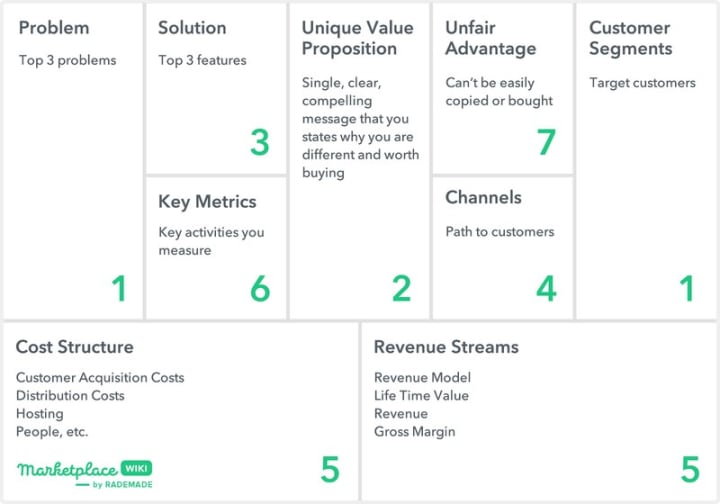How to Outline Your Startup Business Model With Lean Canvas
To execute a successful startup requires a lot of effort and preparation. However, this process is made a lot easier with tools like Lean Canvas.

Startups fall under that branch of business that, if successful, bring the biggest money. Their world is cruel and ruthless. 50% of all new businesses fail within five years because of bad management and inability to follow through on ideas or investments. Even if your idea is stunning, fresh and extremely original, there’s no guarantee that you will make a fortune with it; a great idea is only one part, though a significant one, of a startup's development. Aside from a brilliant idea, your startup has to be well planned: in this case, your chances of thriving grow significantly. Having realized that, Ash Maurya, a successful entrepreneur, came up with the concept of Leanstack, a collection of resources and tools that includes Lean Canvas, a kind of business modeling tool adapted especially for startups that has since been utilized in startup projects all over the world. Lean Canvas allows businesses to create streamlined, 1-page business models comprised of separate 'blocks' that help to outline the project, notice its pros and cons and analyze any potential future risks.

Marketplace Wiki - By RADEMADE
Block 1: Problems vs. Customer Segments
Lean Canvas help the entrepreneur find out whether future possible benefits outweigh the risk taken by the startup. When filling in the Lean Canvas, you should be scrupulously honest with yourself. Don’t exaggerate your future vague benefits or underestimate the problems that you currently face. Think of at least 3 major problems (e.g. lack of investments, lack of place in the market, etc.) and some more minor problems that can cause damage either right now or in the future. Also, research your customer segments and find out as much as you can about your target audience. The more you know about the people your startup is aimed toward, the more improvements you can make. Launching a startup is no time to be dreamy, rather entirely objective and realistic.
Block 2: Unique Value Proposition
Think of what you can offer to your future clients and how you can get them interested in your product. Also, think of your possible investors and how you can rivet their attention toward your project in order to secure their money for your ongoing development. This Lean Canvas block has to show how you’re going to make the idea work. The more creative and daring you are, the better your result is going to be.
Block 3: Finding a Solution
Remember the first two blocks? You described there your current problems and the ideas you want to make work in the future. So, the third block depicts that possible future. Every problem you mentioned earlier has to be accompanied by at least 3 solutions; similarly, every idea proposal has to be accompanied by at least 3 actual steps that can make it happen. If you’re not able to come up with those 3 possibilities for each idea and problem, you’re in big trouble: if the first two ideas don't work, you will need that additional option to keep your startup from falling off track. That’s why thinking of possible solutions now will provide security in the future.
Block 4: Channels
This is where you outline the details on how you plan to reach your target audience. Think of it as a sort of bridge between your product and your future clients. It's up to you to decide what kind of bridge you want to make. It can be a fragile wooden construction that is going to collapse any time or you may build a stable, concrete bridge that will survive any hurricane. Understand that if you fail to make this bridge firm and solid, your startup won’t be able to withstand unexpected obstacles.
Block 5: Cost Structure & Revenue Streams
It’s high time you counted everything. All the expenses matter, big or small. Even if you’re planning to enlist your sponsors for cash, you still need to explain to them what risk they are facing in investing in your project. If you miss one small item of expenditure, it may lead to a complete collapse of your relationship with your investors. Details matter, especially when it comes to a business as risky as startups are.
Block 6: Key Metrics
If, in the previous block, you had to count everything, in this block you have to measure those factors. You have to take into account everything: the attraction your product provides, the motivation of your customers in terms of your product’s usage, and the minimum revenue your startup will be able to provide. Also, one of the biggest attractions for your clients that you likely won’t even think of is going to be things that represent you as a company and promote your brand awareness, e.g. your logo design, your website and your employees who are going to promote your new brand. That’s why these things are really worth considering sooner rather than later.
Block 7: Unfair Advantage
All's fair in love and war, and launching a startup incorporates both simultaneously. It’s love because you’re truly passionate about what you’re doing and are eager for it to work. However, it’s also war against your competitors, investors and all those people who don’t believe in you. The biggest weapon you have is your ace in the sleeve: your unfair advantage. It’s something that distinguishes you from your competitors. Without this hidden advantage you won’t be able to win this war, that’s why you must think twice while jotting it down in your Lean Canvas.






Comments
There are no comments for this story
Be the first to respond and start the conversation.